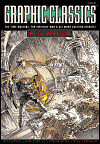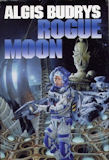
H. G. Wells (Graphic Classics Series), Vol. 3, by H.G. Wells
Book Review by Heather Hunt
Have you read this book?
With 13 different artists adapting 9 different stories, Graphic Classics: H.G.Wells understandably contains a mishmash of styles. The upside to this is that this graphic novel will surely have something to please everyone; the downside is that there will also be something to displease everyone.
I, for example, would have liked to see full story adaptations from title page artist, Kent Steine, frontispiece illustrator, Chris Moore, and Author's Page artist, Jim Nelson. These wonderful artists could have replaced, for example, Dan O'Neill, Milton Knight, and Skip Williams to make the book a better buy for me.
The uneven collection includes some complete misses, such as O'Neill's "The Man Who Could Work Miracles," which looks like it's still at the rough draft stage, and Knight's "The Temptation of Harringay," with undefined illustrations in which you can't tell where one image ends and another begins. It also has some unnecessary additions, such as Lisa Weber's "Le Mari," which has one illustration, and Brad Tear's "The Star," which is all illustration and so minimalist with dialogue that the ending is unclear.
Well's stories "The Invisible Man" and "The Time Machine" are so strong, however, that they shine through regardless of the illustrations, which here are adequate but add nothing to the tales.
Unfortunately, putting so many Wells' stories together reveals their general sameness: A protagonist (usually male) goes to his club and tells what happened to him during his scientific experimentation. The protagonist (and the author) then leaves it up to his colleagues (and the reader) to decide the veracity of his tale. It's a formula that works well if you read a story a day or one a month when the latest SF&F magazine arrives, but it becomes repetitive when read one after another.
By far the best adaptation in word and picture is "War of the Worlds: The Story of Orson Welles' 1938 Radio Broadcast." Antonella Caputo and Nick Miller use clean, clear, bold illustrations and a variety of layouts, including split panels, bursts, pullouts, and whole page panels, to tell the fascinating true story of the panic this broadcast caused. You might call this Welles does Wells so well that listeners believe Earth is actually being invaded.
While there are some gems in this collection, the book is a mixed bag overall so I'm giving it a mixed rating.
I, for example, would have liked to see full story adaptations from title page artist, Kent Steine, frontispiece illustrator, Chris Moore, and Author's Page artist, Jim Nelson. These wonderful artists could have replaced, for example, Dan O'Neill, Milton Knight, and Skip Williams to make the book a better buy for me.
The uneven collection includes some complete misses, such as O'Neill's "The Man Who Could Work Miracles," which looks like it's still at the rough draft stage, and Knight's "The Temptation of Harringay," with undefined illustrations in which you can't tell where one image ends and another begins. It also has some unnecessary additions, such as Lisa Weber's "Le Mari," which has one illustration, and Brad Tear's "The Star," which is all illustration and so minimalist with dialogue that the ending is unclear.
Well's stories "The Invisible Man" and "The Time Machine" are so strong, however, that they shine through regardless of the illustrations, which here are adequate but add nothing to the tales.
Unfortunately, putting so many Wells' stories together reveals their general sameness: A protagonist (usually male) goes to his club and tells what happened to him during his scientific experimentation. The protagonist (and the author) then leaves it up to his colleagues (and the reader) to decide the veracity of his tale. It's a formula that works well if you read a story a day or one a month when the latest SF&F magazine arrives, but it becomes repetitive when read one after another.
By far the best adaptation in word and picture is "War of the Worlds: The Story of Orson Welles' 1938 Radio Broadcast." Antonella Caputo and Nick Miller use clean, clear, bold illustrations and a variety of layouts, including split panels, bursts, pullouts, and whole page panels, to tell the fascinating true story of the panic this broadcast caused. You might call this Welles does Wells so well that listeners believe Earth is actually being invaded.
While there are some gems in this collection, the book is a mixed bag overall so I'm giving it a mixed rating.
|
Click here to buy H. G. Wells (Graphic Classics Series), Vol. 3, by H.G. Wells on Amazon
|
H. G. Wells (Graphic Classics Series), Vol. 3, by H.G. Wells on Amazon

| More Books You Might Like |
Comment on H. G. Wells (Graphic Classics Series), Vol. 3, by H.G. Wells
| Comments on H. G. Wells (Graphic Classics Series), Vol. 3, by H.G. Wells |
| There are no comments on this book. |




